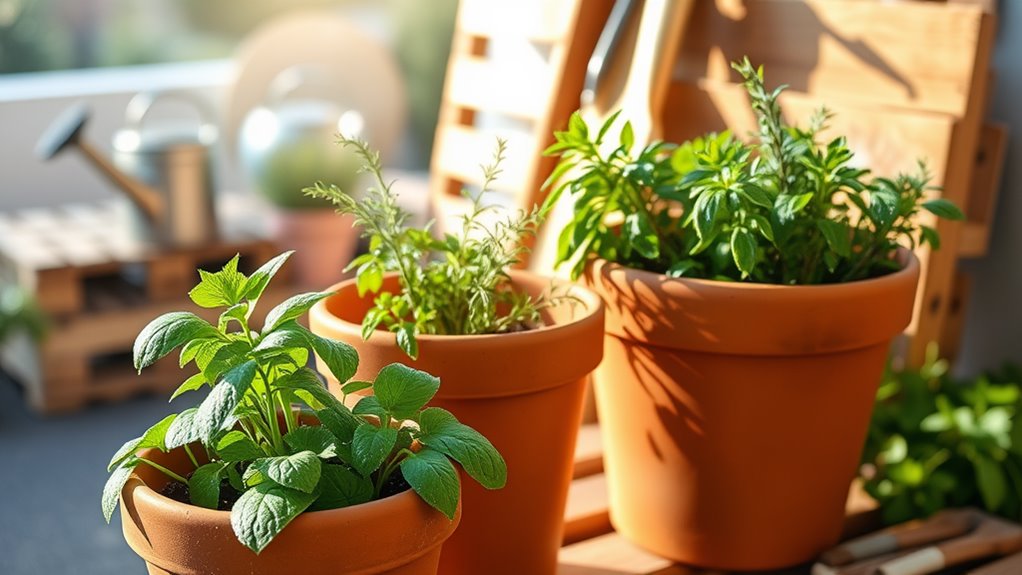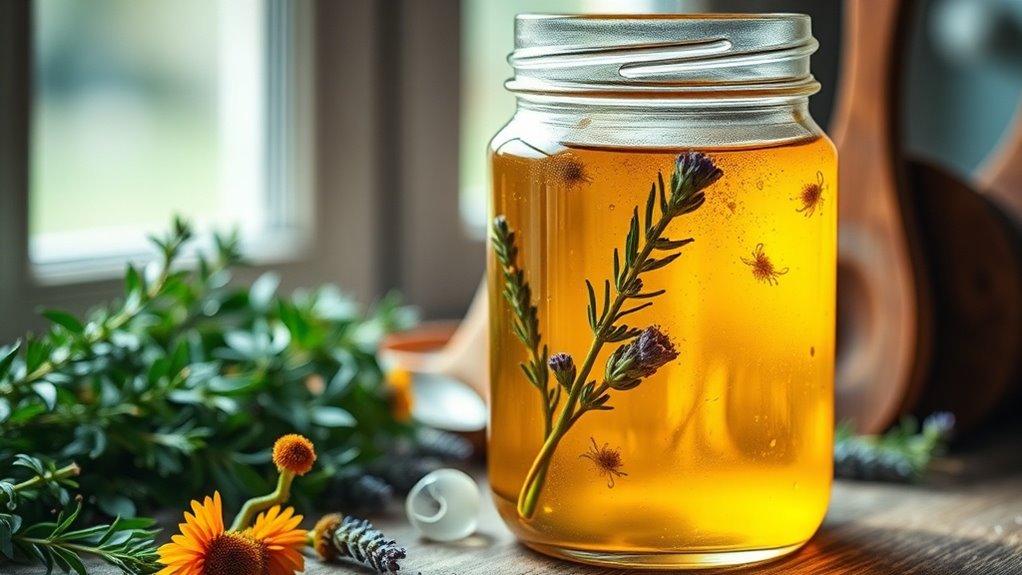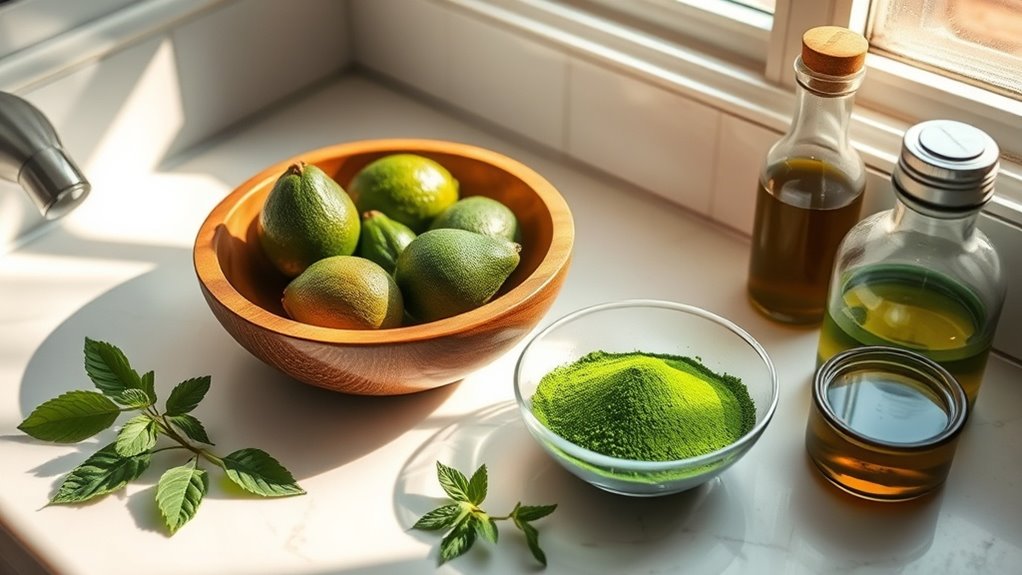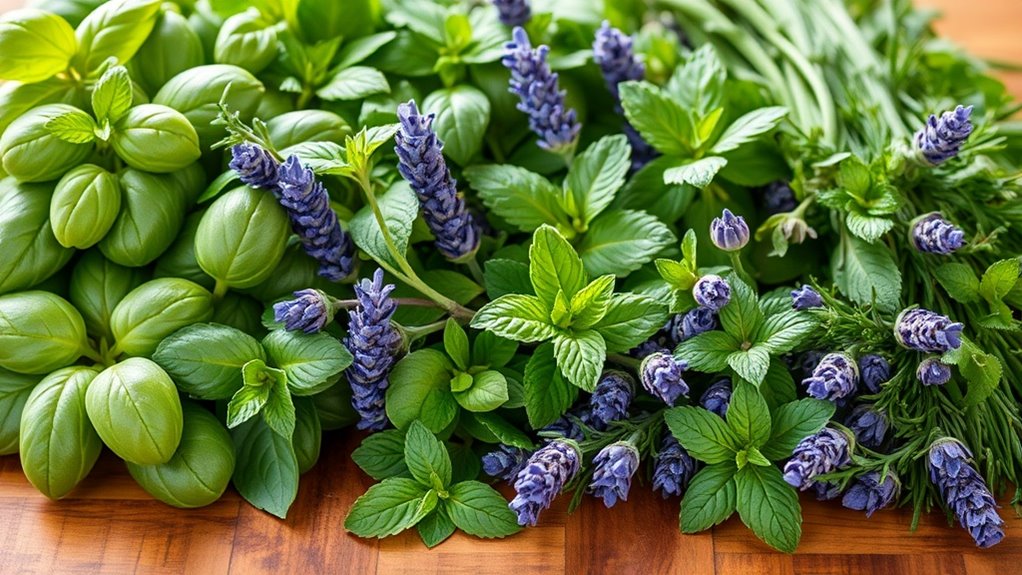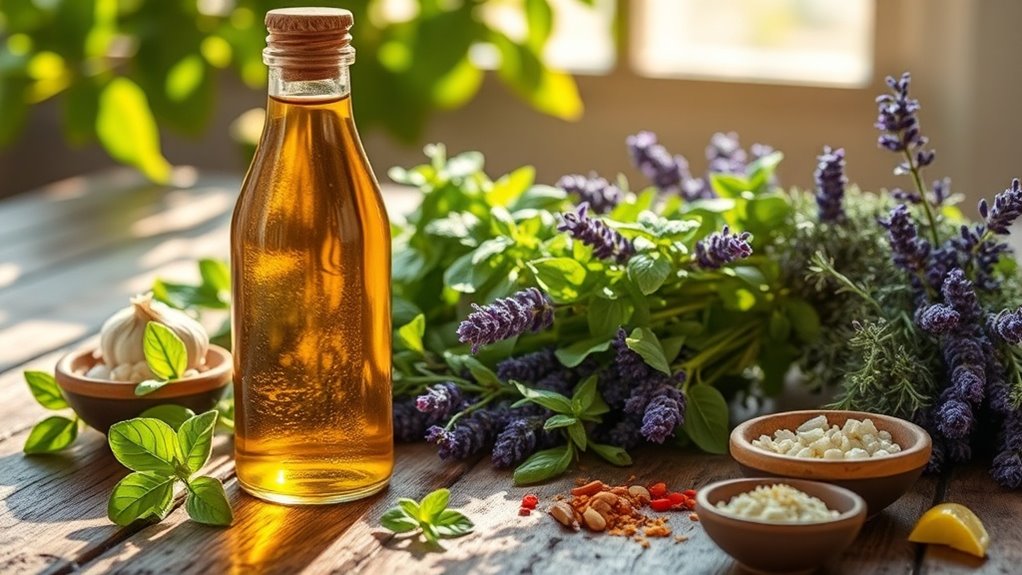How I Started My Herb Garden With Only a Few Pots
Starting your herb garden with just a few pots is simpler than you think! First, choose herbs that you love, like basil or mint, and find a sunny spot for them. Use well-draining soil in pots with drainage holes, ensuring they’re the right size for your herbs. Water them when the top inch of soil feels dry, and don’t forget to prune regularly. With a little care, you’ll soon enjoy fresh flavors right from your garden. Let’s explore how to maintain your mini oasis!
Choosing the Right Herbs for My Garden
When it comes to choosing the right herbs for your garden, how do you decide which ones will thrive in your space?
For mini herb gardening, consider your culinary preferences and the light conditions in your area.
Basil and parsley flourish in sunny spots, while mint thrives in partial shade.
Think about the flavors you enjoy most; if you love Italian dishes, basil is a must.
Start with a few easy-to-grow herbs, like chives or cilantro.
These vibrant plants not only enhance your meals but also bring life to your space.
It’s important to understand your light conditions for optimal growth in an indoor setting.
Embrace the joy of growing your own herbs!
Selecting the Ideal Pots and Soil
When you’re setting up your herb garden, choosing the right pots and soil is crucial for your plants’ success.
Consider the size of your pots carefully, as it impacts how well your herbs grow, while selecting the right soil type can make all the difference in nutrient delivery.
Don’t overlook drainage either, because proper water flow keeps your herbs healthy and thriving. Additionally, using mason jars as containers can provide excellent drainage techniques for your herbs, ensuring they remain well-aerated and healthy.
Pot Size Considerations
How do you choose the right pots for your herb garden?
Start by considering the size of the herbs you plan to grow.
For smaller herbs like basil or parsley, 6-8 inch pots work well.
If you’re opting for larger varieties like rosemary or mint, go for 10-12 inch pots.
Make sure your pots have drainage holes to prevent waterlogging and encourage healthy root growth.
Choose materials that suit your style—terracotta offers breathability, while ceramic adds a touch of elegance.
Lastly, remember that you can always mix and match sizes for a visually appealing arrangement that fits your space.
Soil Types Explained
Choosing the right pots sets the stage for your herb garden, but the soil you use can make all the difference in your plants’ growth and flavor.
For herbs, a well-draining potting mix is essential.
Look for a blend that includes peat moss, perlite, or vermiculite—these ingredients help retain moisture while allowing excess water to escape.
You might also consider organic options, which can enrich your plants with nutrients.
Avoid heavy garden soil; it can compact and suffocate roots.
Drainage Importance
Have you ever wondered why drainage is crucial for your herb garden?
Without proper drainage, your herbs can drown in waterlogged soil, leading to root rot and stunted growth.
When selecting pots, choose those with drainage holes to allow excess water to escape.
Terracotta pots are great for their breathability, while lightweight plastic ones can retain moisture without becoming soggy.
Pair your pots with well-draining soil, like a mix of potting soil and perlite.
This combination ensures your herbs receive the right amount of water, promoting healthy growth and vibrant flavors in your homegrown garden.
Happy gardening!
Planting My Herbs: Step-by-Step
Now that you’ve picked the perfect pots and soil, it’s time to select the herbs that will thrive in your space.
Think about what you love to cook with and how much sunlight your pots will receive.
Once you’ve chosen your herbs, you’ll want to master the potting and watering techniques to ensure they flourish beautifully. Additionally, using recycled jars as containers not only adds charm but also promotes sustainability in your herb garden.
Choosing the Right Herbs
When it comes to selecting herbs for your garden, how do you know which ones will thrive in your space and suit your culinary preferences?
Start by considering the herbs you love to use in the kitchen.
Basil, parsley, and thyme are excellent choices for beginners and versatile in many dishes.
Think about your climate too; some herbs prefer sunny spots, while others thrive in partial shade.
Don’t forget to check the growth habits; some herbs can take over a pot if you’re not careful.
Choose a mix of favorites and experiment with new ones to keep your culinary adventures exciting!
Potting and Watering Techniques
To successfully pot and water your herbs, it’s essential to start with quality soil and the right containers. Choose pots with drainage holes to prevent root rot. Fill each pot with a nutrient-rich potting mix, leaving space for your herbs.
| Herb | Watering Frequency | Sunlight Requirements |
|---|---|---|
| Basil | Every 3-4 days | 6-8 hours daily |
| Mint | Every week | 4-6 hours daily |
| Rosemary | Every 2 weeks | 6-8 hours daily |
After planting, give your herbs a thorough watering, ensuring the soil is moist but not soggy.
Watering and Sunlight Needs
While establishing your herb garden, understanding the watering and sunlight needs of your plants is crucial for their growth and health.
Most herbs thrive with about six to eight hours of sunlight daily, so find a sunny spot for your pots.
When it comes to watering, aim for consistency—water your herbs when the top inch of soil feels dry.
Be cautious, though; overwatering can lead to root rot.
Each herb has its preferences, so keep an eye on your plants.
Basil loves moisture, while rosemary prefers drier conditions.
To create a successful indoor garden, be sure to provide a sunny spot that allows your herbs to flourish.
Tailoring your care will yield a lush, vibrant herb garden!
Maintaining My Herb Garden
As you nurture your herb garden, regular maintenance becomes essential for keeping your plants healthy and productive.
Start by checking the soil moisture; herbs prefer slightly dry conditions, so don’t overwater. Prune your herbs regularly to encourage bushier growth and prevent them from becoming leggy. Keep an eye out for weeds that compete for nutrients; a quick hand-pulling session can do wonders. Fertilize sparingly with an organic option to boost growth. Lastly, rotate the pots occasionally to ensure even sunlight exposure. Remember that fresh herbs not only enhance your dishes but also bring a sense of accomplishment and joy to your gardening experience.
With these simple steps, your herb garden will flourish, providing fresh flavors for your culinary adventures.
Troubleshooting Common Issues
Even with proper maintenance, you might encounter a few hiccups in your herb garden.
If your herbs look wilted, check the soil moisture—overwatering or underwatering can be the culprits.
Yellowing leaves often signal nutrient deficiencies, so consider adding a balanced fertilizer.
Watch out for pests like aphids; a gentle spray of water or insecticidal soap can help.
If your herbs are leggy, they may need more sunlight; try moving them to a brighter spot.
Incorporating a tranquil garden sanctuary not only enhances your herbs’ growing conditions but also promotes personal well-being through the healing power of nature.
Harvesting and Using Fresh Herbs
Once your herbs have grown to a healthy size, it’s time to enjoy the fruits of your labor by harvesting and using them in your favorite dishes.
Gently snip the leaves or stems, ensuring you leave enough for the plant to continue thriving.
Fresh herbs like basil and parsley can elevate a simple pasta or salad, adding vibrant flavors.
Try mixing chopped herbs into marinades or sprinkling them over roasted vegetables for a burst of freshness.
Remember, you can always dry or freeze excess herbs to preserve their goodness. Additionally, many herbs provide medicinal properties that can enhance overall well-being.
Embrace the opportunity to enhance your meals with your homegrown treasures!
The Joys of Homegrown Herbs
The joys of homegrown herbs extend far beyond your kitchen.
Here are some reasons to celebrate your green thumb:
- Fresh Flavors: Your meals burst with vibrant, fresh tastes that store-bought herbs can’t match.
- Aromatherapy: The scents of rosemary, basil, and mint create a calming atmosphere in your home.
- Health Benefits: Homegrown herbs are packed with nutrients, boosting your well-being naturally.
- Personal Satisfaction: Watching your plants thrive gives you a sense of accomplishment and connection to nature.
- Culinary Uses: Many essential herbs can elevate your dishes, making them more flavorful and nutritious.
Embrace the joy of nurturing your herbs!

